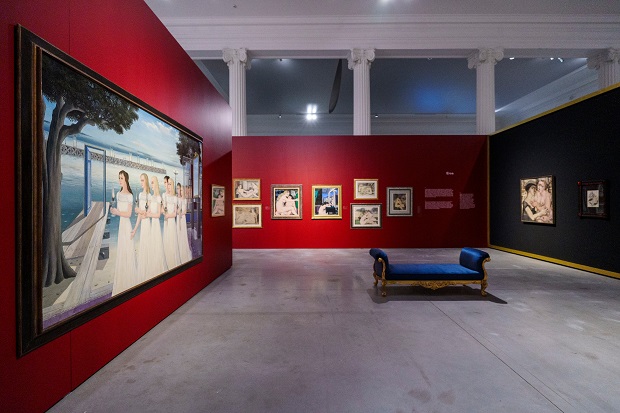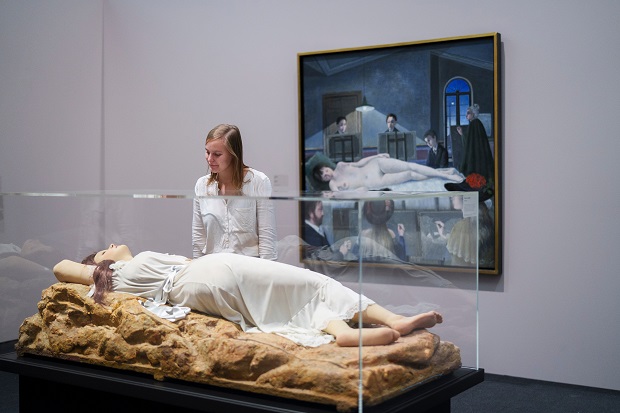- Daily & Weekly newsletters
- Buy & download The Bulletin
- Comment on our articles
Paul Delvaux retrospective at La Boverie in Liège invites a rediscovery of the artist’s world
If the centenary of Surrealism prompted this major retrospective of Paul Delvaux’s work, it is the Belgian artist’s entire creative universe that falls under the spotlight at La Boverie in Liège.
Offering more than 150 works that span his artistic career, The Worlds of Paul Delvaux delves into the many lesser-known strands of his work. It is the first retrospective since 1997 when the Royal Museums of Fine Arts of Belgium celebrated the centenary of his birth.
But beyond Surrealism, Delvaux played an influential role in other leading art movements of the 20th century, even if his reputation was eclipsed on the world art stage by his contemporary René Magritte.
The exhibition is divided into different themes surrounding the principal iconographic elements that formed his artistic universe. Paintings, drawings and objects are grouped together to highlight the motifs that reappeared throughout Delvaux’ career, such as melancholy, vestals, trains, skeletons, antique emblems and his Sleeping Venus series of paintings.

Renowned for his large-scale dreamy compositions of nudes and railway scenes in often bizarre and ambiguous settings, Delvaux’s highly naturalistic painting technique compounds the uneasy atmosphere that accompanies his works. Although he didn’t tackle political subjects, the backdrop of war and the rise of fascism was ever present in his formative years.
In addition to paintings of Delvaux by pop artist Andy Warhol, his works are also contrasted by the inclusion of other artists. Magritte and De Chirico are natural partners due to their connections with Surrealism. Less obvious is Modigliani, who was responsible for encouraging Delvaux in his depiction of nudes. He was also involved in Expressionism, the movement which dominated the Belgian art scene in the 1930s, so there are links to fellow Belgians Constant Permeke and Gustave De Smet, while the interest in antiquity and skeletons creates interesting counterpoints with Picasso, Ensor and Rops.

A timeline shows the important moments in Delvaux’s life and career, including his early architecture studies in Brussels, setting up an art studio in his parents’ Saint-Gilles home and his first solo exhibition at the Palais des Beaux-Arts, now Bozar, in 1936. Married twice, Delvaux taught painting at La Cambre from 1950 and had homes at Sint-Idesbald on the Belgian coast as well as Boitsfort in the capital. Major exhibitions and retrospectives ensued in Belgium and abroad. In 1978 he painted a monumental fresco Nos vieux trams bruxellois at the Bourse metro in Brussels, and in 1982 the Paul Delvaux Museum was established in his Sint-Idesbald home and studio. Delvaux died at nearby Veurne in 1994.

Among the many masterwork paintings on display is the 1960 La gare forestière (pictured), which is representative of his predilection for trains and stations that dated from his childhood fascination with Brussels’ streetcars. The turned backs of the two small girls in the foreground and eerie dusk light add to the slightly menacing tone as well as the mysterious station.

Religious iconography is often present as in La Mise au tombeau (pictured), a personal and macabre interpretation of the Passion with a dramatic staging of Christ, the Virgin Mary and onlooker all in the form of skeletons. An earlier version of the 1951 painting provoked a scandal in 1954 when on show in the Belgian Pavilion at the Venice Bienniale with the clergy calling for it to be removed.

Nude women are of course a hallmark of Delvaux’s work, occupying a place somewhere between the realm of statuary and of sex objects, as in the 1954 L’Aube (pictured). The ambiguity of these female figures, their icy detachment, contribute to an omnipresent tension, along with the unusual perspective and vanishing points.
While inviting the public to discover or rediscover Delvaux’s multi-facetted oeuvre, the retrospective explores his creative process via interactive multimedia devices. An original reconstruction of his studio, shows the artist working from a model, and there is a glimpse into the creative process of a painting with Rumeurs (1980) on display, along with a preparatory drawing for the work. A film also outlines the changes introduced by the artist during the painting’s production phase.
Visitors can also take inspiration from the artist’s iconography and have a go at composing their own Delvaux with an interactive device called “Draw me a Delvaux”.
The Worlds of Paul Delvaux
Until 16 March
La Boverie
Parc de la Boverie
Liège
Photos: (main image) Paul Delvaux Le Tunnel 1978 ©Foundation Paul Delvaux SABAM 2024 ©photo Vincent Everarts; Delvaux 2024 La Boverie ©Tempora cdbcreation; Paul Delvaux La Gare forestiere 1960 © Foundation Paul Delvaux SABAM 2024 ©photo Vincent Everarts; Paul Delvaux La Mise au tombeau 1953, La Boverie Liege ©Foundation Paul Delvaux SABAM 2024 ©photo Vincent Everarts; Paul Delvaux L’Aube 1943, Musee Paul Delvaux ©Foundation Paul Delvaux SABAM 2024 ©photo Vincent Everarts



















